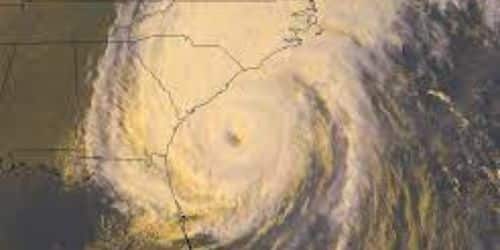Are you thinking of visiting the North Carolina coast? As such, you’re curious about when the 2023 Atlantic hurricane season will begin and end. The Atlantic hurricane season generally runs from June 1 to November 30, while hurricanes form in the Eastern Pacific from May 15 to November 30. But, when exactly does the 2023 North Carolina hurricane season begin? North Carolina hurricane season officially begins in June and ends in November, with the peak months being August, September, and October. Generally, in hurricanes risk, North Carolina ranks as the fourth most dangerous state in the United States. Tar Heel State residents should be especially vigilant during the months of August, September, and October, which are peak hurricane months in the Atlantic hurricane season (which officially begins on June 1 and ends on November 30).
What Months is Hurricane Season in NC?
North Carolina experiences hurricane season from June 1 through November 30. Although September through November is peak season, hurricanes can and do make landfall at any time of year. For instance, Hurricane Florence made landfall in North Carolina on September 14, 2018, as a Category 4 storm and caused extensive damage across the state. While, on October 10 as a Category 4 storm, Hurricane Michael made landfall in North Carolina.
When is the Peak Hurricane Season in North Carolina?
The months of August through October, this is when North Carolina is most vulnerable to hurricanes. Since 1851, North Carolina has been hit by 58 of the 301 hurricanes that have made landfall in the United States. These hurricanes have ranged in intensity from Category 1 to Category 5.
In September of 2018 for instance, Hurricane Florence was the latest big hurricane to hit North Carolina, causing an estimated $22 billion in damages across the Tar Heel State. Recent history shows that September and October are peak months for storm activity in the state.
Here is NOAA’s prediction for the 2023 hurricane season.
- We can expect between 14 and 21 storms to be named.
- Six to ten of them might develop into storms (wind speeds of 74 mph or higher)
- A range of roughly 3–6 major hurricanes (Category 3, 4, or 5) (wind speeds of 111 mph or higher)
Saffir-Simpson Hurricane Wind Scale.
During hurricane season, many people in coastal areas of the United States leave their homes and seek shelter further inland. However, people may take unwarranted chances if they are worried about a hurricane making landfall. If a hurricane is threatening your area, it is crucial that you know how to read the Saffir-Simpson Hurricane Wind Scale so that you can prepare accordingly.
In order to quantify the destructive potential of hurricanes, the Saffir-Simpson Wind Scale is employed. Category 1 storms have the least powerful winds, while Category 5 storms have the most. Maximum sustained winds for a Category 1 hurricane range from 74 to 95 miles per hour, as shown in the preceding table.
In addition, there is a high risk of widespread devastation from a Category 5 storm, which has maximum sustained winds of 157 miles per hour or more. Homes and other structures are not safe from them. Hence, you should leave the path of a Category 5 storm immediately.
How to Get Ready for Hurricane Season in North Carolina
You can do a lot to get ready for a hurricane. Having an evacuation route planned out, a supply cache, and a solid game plan are all essential.
Generally, as a resident of a hurricane-prone region, you should always be prepared. Having a plan for when a hurricane is approaching, and if necessary, leaving is an important part of being prepared. Ensure that all family members are aware of and can access the plan.
Be sure to have enough supplies on hand. Such necessities as food, drink, batteries, and lights fall under this category. In addition, if you live in a hurricane-prone area, investing in a generator could be a wise precaution.
One last thing: plan an escape route. Be ready to make a quick exit if a hurricane is approaching.
Taking Stock of Damages and Restoration Efforts After the Storm
After the storm has passed, it’s time to take stock of the damage and get to work fixing it. Generally, there is always support available to you if you find yourself in need. If you are looking for details on North Carolina’s disaster aid programs, you can consult the list of Disaster Recovery Centers provided by the state’s Department of Public Safety.
Being ready for hurricane season is crucial. Hence, if a hurricane is approaching, you should be prepared and know what to do. During this time of year, please take care to avoid harm.
How often is North Carolina hit by hurricanes?
According to the North Carolina State Climatology Office’s statistical analysis of hurricane activity along the coast between 1883 and 1996, a tropical cyclone makes landfall once every four years, on average. The state has been impacted by an estimated 17.5 percent of all tropical cyclones in the North Atlantic.
Does North Carolina Get Hurricanes Every Year?
Since 1851, the North Carolina Department of Natural Resources has been keeping tabs on tropical storms, and its records reveal the annual likelihood of a hurricane making landfall in the state.
Over the 169-year period from 1851 to 2020, a total of 84 tropical cyclones made landfall in North Carolina or an annual average of 2.
The average frequency of a hurricane making landfall in North Carolina is around once every 3.25 years, with 84 tropical storms, 52 of which were hurricanes.
Just because a hurricane makes landfall in North Carolina on average once every three years doesn’t mean it will in 2023.
Is North Carolina Hit by Hurricanes?
Because of its long coastline, North Carolina is basically one of the states most at risk of being hit by a hurricane. In the previous 20 years, hurricanes have impacted every part of the state, from the coast and the sea to the highlands.
What Part of North Carolina is Safe from Hurricanes?
Charlotte
Though Charlotte is in a hurricane-prone state, its inland location allows it to avoid the worst of the storms. Other dangerous natural disasters, such as earthquakes, fires, and tornadoes, are not likely to strike the region.
What Part of NC Gets the Most Hurricanes?
The findings show that Cape Hatteras, near North Carolina’s Outer Banks, is the worst area in the country. There have been 108 hurricanes or tropical storms that hit the city since 1871. As a result, the coastal city can expect to be pounded by a storm once every 1.33 years.
What is the Safest State from Hurricanes?
New Hampshire
New Hampshire, which borders both Vermont and Maine, also has a low risk of earthquakes and tornadoes. Most hurricanes weaken considerably before hitting New Hampshire because of its northern location.
What month does North Carolina have the most hurricanes?
During the months of August through October, North Carolina is most vulnerable to hurricanes. North Carolina has been hit by 58 of the 301 hurricanes that have hit the United States since 1851. These hurricanes have ranged in intensity from a Category 1 storm to a Category 5 hurricane.
In September of 2018, Hurricane Florence was the latest big hurricane to hit North Carolina, causing an estimated $22 billion in damages across the Tar Heel State. Recent history shows that September and October are peak months for storm activity in the state.
How to Prepare for North Carolina Hurricane Season
North Carolinians need to get ready for hurricane season in advance because of the frequency with which storms strike the state. Here are some precautions you may take before, during, and after the storm to protect your house and loved ones.
Before the Storm
- Invest in flood insurance
- Check that your house insurance policy has adequate wind coverage before the storm hits.
- Make a kit and contingency plan
- Recognize your escape routes
- Protect your property.
- Observe hourly weather reports
- Fill up your cars with gas
During the Storm
- Keep up with the weather reports
- Close the storm doors
- If instructed to do so by authorities, turn off the power, water, and gas.
- If you are told to leave your residence by government agents, do so immediately.
- OFFSET the propane tanks
- Take refuge in a room, bathroom, or hallway without windows.
- Stay inside and keep away from windows and doors if you can’t leave your house.
Following the Storm
- To locate the closest shelter in your region, text SHELTER + your ZIP code to 43362 (4FEMA).
- Avoid slack or downed electrical lines.
- Keep up with regional alerts
- Avoid using flooded or washed-out roadways.
- Photograph the damage.
- If you can, make interim, urgent repairs to your house and keep the invoices.
- Submit a claim to your insurance provider.
Which States Have Never Experienced Hurricanes?
There is a huge blank space above the Mid-Atlantic coast on a map showing where hurricanes have made landfall in the United States since 1851. Delaware, Maryland, and Virginia have never been directly hit.
Where in the United States Do Hurricanes Strike Most Frequently?
Since the Saffir/Simpson scale was established in 1851, Florida has experienced more hurricanes than any other state, which presumably comes as no surprise. It is generally vulnerable to storms that originate from either the Atlantic Ocean or the Gulf of Mexico due to its placement between both.
In fact, Florida has been impacted by more than 41% of the 292 hurricanes that have struck the United States since 1851. Texas is the state that experiences storms the second most frequently, which may not surprise many people given that the Gulf of Mexico is notorious for producing some very powerful hurricanes.
However, North Carolina is the most hurricane-prone state that does not border the Gulf of Mexico and has been hit by 55 hurricanes since 1851, making it the third most hurricane-prone state in the United States.
What are the Top 10 States that Hurricanes Hit the Most in the United States?
The top 10 hurricane states on record, from hurricane seasons in 1851 through 2018, are as follows:
1. Florida: 120 hurricanes (37 were Category 3 through Category 5)
2. Texas 64 hurricanes (19 were Category 3 through Category 5)
3. North Carolina: 55 hurricanes (7 were Category 3 through Category 5)
4. Louisiana: 54 hurricanes (17 were Category 3 through Category 5)
5. South Carolina: 30 hurricanes (5 were Category 3 through Category 5)
6. Alabama had 24 hurricanes (5 were Category 3 through Category 5)
7. Georgia 22 hurricanes (3 were Category 3 through Category 5)
8. Mississippi 19 hurricanes (8 were Category 3 through Category 5)
9. New York: 15 hurricanes (3 were Category 3 through Category 5)
10. Massachusetts 12 hurricanes (1 was a Category 3)
You might or might not be surprised to learn that Florida has had nearly twice as many hurricane strikes than Texas, the state that has experienced the second-most. Given that Hurricane Katrina was one of the most catastrophic natural disasters ever, you might also be shocked to see that Louisiana came in at number four.
On the other hand, the Pacific Coast of the United States has never been directly hit by a hurricane, despite the fact that there is a Pacific hurricane season that normally takes storms near Mexico before turning back to sea toward Hawaii.
Conclusion
Hurricanes appear to strike the United States in quick succession every year. However, those three catastrophic hurricanes in the previous two seasons may only be to blame for that idea.
The last two hurricane seasons saw the occurrence of Hurricanes Michael, Harvey, and Irma, which are among the ten most destructive storms to strike the United States. However, hurricanes of this magnitude haven’t always been common.
As such, North Carolinians need to get ready for hurricane season in advance because of the frequency with which storms strike the state. You can do a lot as an inhabitant of North Carolina to get ready for a hurricane. Having an evacuation route planned out, a supply cache, and a solid game plan are all essential.
North Carolina Hurricane Season FAQs
Where in North Carolina do hurricanes occur?
Generally, hurricanes have hit every region of North Carolina over the past two decades. However, North Carolina’s coast is particularly vulnerable to hurricanes and floods.
Is North Carolina at risk for hurricanes?
When it comes to hurricanes, North Carolina is one of the most vulnerable states. The state’s protruding shoreline into the Atlantic acts like a catcher’s glove, sucking in storms as they make their way up the coast.
Related Articles
- GREEN ENERGY COMPANIES: 15 Best Green Energy Companies To Invest in The UK
- HO-6 Homeowners’ Insurance Policy: Coverages and Costs
- ALL RISK INSURANCE: Definition, Coverage, and When You Need It
- PERSONAL PROPERTY INSURANCE: Coverages and Policies






